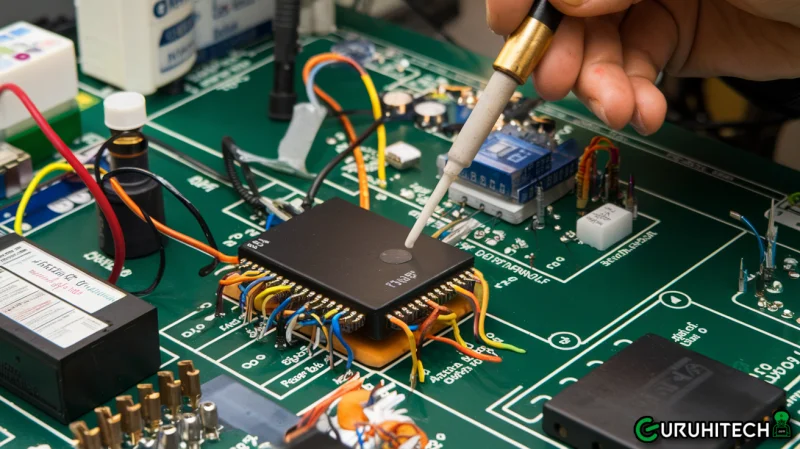What solders and soldering fluxes are used in electronics that are water-washable?

Author Dmitrii Khramtsov. Florida, USA. September 14 2024.
Cleaning printed circuit boards after soldering or repairing is done not with tap water but with distilled water! Why is this so important? Tap water is technically dirty and is not suitable for cleaning printed circuit boards. It contains many minerals, metals, and salts, which will inevitably come out after cleaning in the form of white and gray plaque. That is why cleaning with distilled water, either purchased or prepared using a distiller, is necessary.
Indeed, you noticed that there are no solder pastes in the title of the article. This is explained very simply – the use of organic solder pastes with water-washable WC flux is very risky in relation to those components that have hidden cavities QFN, BGA, FPGA, and the like. It is necessary to proceed from the fact that some of the soldering fluxes will remain under the components and our task is to ensure that these residues do not harm the printed circuit board and components. For these tasks, it is necessary to use no-clean NC soldering pastes with 0% halogens. This will ensure operability even if there are flux residues under the components.
Selecting a solder alloy.
And now, when it is necessary to solder pin/pin components, we need to select a tubular solder alloy.
Determine the alloy:
1) Lead Pb60Sn40, Pb61Sn38, Pb63Sn37, Pb62Sn36Ag2.
2) Lead-free Pb96.5Ag3Cu0.5, Sn96.5/Ag3.5, Sn98/Ag2.
In reality, there is a huge range of alloys for any task. You should remember that the comfortable soldering temperature for lead solders is 320 degrees. For lead-free solders, 350 degrees. Of course, a lot depends on the board topology and the heat capacity of the components. The temperature of the tips must be approached quite carefully since the higher the temperature of the tip, the faster it burns out.
Note: water-washable fluxes contribute to the rapid burning of tips, since the chemistry of water-washable fluxes is organic compounds.
And only now, after we have decided on the alloy, we approach the choice of flux, which we will solder. Soldering Flux can be both in the composition of tubular solder and purchased separately.
There are 3 types of fluxes for soldering:
- Rosin Rosin (RO);
- Synthetic Resin (RE);
- Organic Organic (OR);
The activity of soldering fluxes:
The first two letters, RO-RE-OR, are followed by the third letter, indicating the flux activity: L(low) – M(medium) – H(High).
Also the higher the flux activity, the higher its ability to solder a bad and oxidized connection, but any remnants of active fluxes on the printed circuit board cause corrosion after some time. That is why highly active fluxes are almost never soldered into critical microcircuits with hidden cavities QFN, BGA, and FPGA. Even if you have the coolest industrial cleaning system, it does not guarantee 100% cleaning of hidden cavities. However, it is quite possible to use highly active fluxes for open components.
I do not use soldering fluxes higher than class ROL0, both in repairs and when soldering new components. Most often I use the soldering flux for electronics Diamond Flux FN231 in a 10g syringe.
Now, we need to pay attention to the number after the main flux formula. It is either 0 or 1. It only means the halogen content is increased or decreased.
Let’s continue… The higher the activity, the more halogens the flux contains. Halogens are distributed as follows:
- L0 – 0%, L1 – 0.15%
- M0 – 0.15%; M1 – 1.5-2%
- H0 – 0.15%; H1> 2%
Fluxes with halogen content> 0.15% must be cleaned.
Finally, we have come to the most important thing – choosing a solder with a water-washable flux. Fluxes with the abbreviation OR = water-washable. We are already talking about mandatory cleaning because these organic fluxes are mostly highly active and have a high halogen content. In industrial stores, you can find solders with fluxes ORL0, ORL1, ORM0, ORM1, ORH0, ORH1. They are all water-washable.
If you need a separate flux for soldering electronic PCBs, then its selection is carried out exactly according to the same principle. It is usually sold in 1 liter containers.
I hope that I have helped to understand the terminology.
Ti potrebbe interessare:
Segui guruhitech su:
- Google News: bit.ly/gurugooglenews
- Telegram: t.me/guruhitech
- X (Twitter): x.com/guruhitech1
- Bluesky: bsky.app/profile/guruhitech.bsky.social
- GETTR: gettr.com/user/guruhitech
- Rumble: rumble.com/user/guruhitech
- VKontakte: vk.com/guruhitech
- MeWe: mewe.com/i/guruhitech
- Skype: live:.cid.d4cf3836b772da8a
- WhatsApp: bit.ly/whatsappguruhitech
Esprimi il tuo parere!
Ti è stato utile questo articolo? Lascia un commento nell’apposita sezione che trovi più in basso e se ti va, iscriviti alla newsletter.
Per qualsiasi domanda, informazione o assistenza nel mondo della tecnologia, puoi inviare una email all’indirizzo [email protected].
Scopri di più da GuruHiTech
Abbonati per ricevere gli ultimi articoli inviati alla tua e-mail.
